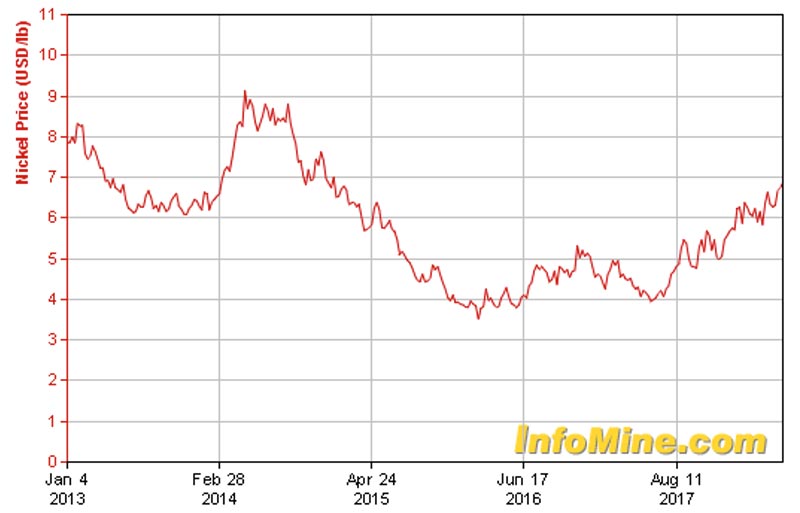What you need to know about history as nickel revival gathers pace
Mining
Mining
Nickel booms come, and nickel booms go, and while there is one very good reason to believe that a new boom is developing it would be wise to remember that nickel is a name that rhymes with fickle.
Before the bad news it is worth considering the good because it is possible that the latest surge in the nickel price to a four-year high of more than $US7 a pound has ignited interest in a crop of largely forgotten small nickel stocks.
Panoramic Resources (ASX:PAN), for example, last week hit a 12-month share-price high of 64c thanks to the re-development of its mothballed Savannah mine in the Kimberley region of WA.
Independence Group (ASX:IGO) and Western Areas (ASX:WSA), two survivors from a four-year nickel-price downturn have also been nudging 12-month price highs.
Galileo Mining (ASX:GAL), a new float from the stable of thoroughbred explorers trained by super-rich prospector, Mark Creasy, delivered a double-your-money experience for subscribers when its 20c shares moved directly to 40c after listing late last month, before easing to 36c.
The re-birth of nickel as an Australian mining speciality has kick-started interest in a wide range of stocks that include Mincor, Western Areas, St George Mining, Golden Mile Resources, and Rox Resources.
What’s changed is that nickel — a metal once dubbed the devil’s metal because it was so hard for early metallurgists to extract from its native rocks — is developing what could become a fast-growing market — batteries in electric cars.
Until recently about 80 per cent of the world’s nickel was used in the production of stainless steel.
It was a metal equivalent of a one-trick pony, almost totally dependent on demand for stainless, as well as being exposed to new sources of supply such as a Chinese-developed technique for extracting nickel from low-grade ore (a process dubbed Nickel Pig Iron or NPI).

The battery market has been a secondary factor for nickel over the past 20 years.
Early mobile phones used a nickel-metal hydride battery (Ni-MH), as do many of today’s devices which use rechargeable batteries.
Electric vehicles are a dramatically bigger market for rechargeable batteries for the obvious reason that a car is bigger than a mobile phone and requires bigger batteries and more of them.
One of the big metallic winners
If the electric car revolution is real then nickel will be one of the big metallic winners, perhaps even more so than the current battery stars, lithium, cobalt and graphite.
Citi, an investment bank, reckons that over the next 15 years demand for battery grade nickel (and not all nickel qualifies as battery grade) will soar from a current 3 per cent of consumption to 30 to 40 per cent.
Over the same time demand for stainless steel is also likely to continue rising. While other metals such as manganese can be used to make stainless, nickel is best.
So, from being a one-trick pony nickel is looking at a future where it has a big new market that’s a potential game changer — and the source of another nickel boom.
We have been here before
The problem, and one for investors to note carefully, is that we have been here before with nickel — a metal which can create fortunes, and destroy them.
My experience with nickel started when working for a Canadian nickel explorer active in WA in the late 1960s — a time of the Kambalda discoveries by Western Mining Corporation, followed by the spectacular Poseidon boom.
Australia’s last nickel boom was in 2007 when the price rocketed from around $US7/lb (roughly where it is today) to a peak of $US23/lb.
That saw one of the great local success stories of the time Jubilee Mines snapped up by Xstrata Mining for a whopping $2.8 billion — with $500 million going to Jubilee’s founder, Perth-based Kerry Harmanis.
Batteries could spark a fresh nickel boom, and perhaps this time there will not be a bust after the boom.
But seasoned market observers are already ringing a warning bell that the nickel sector is getting ahead of itself. While there is a big new market developing for nickel it’s not here yet and might takes decades to fully develop.
Runaway metal
Investment bank Morgan Stanley last week described nickel as a “runaway” metal with “fundamental downside risk, but with the market firmly focused on the future”.
Part of the Morgan Stanley warning thesis is that speculators have been soaking up spare nickel ahead of the forecast battery boom. This buying spree has shrunk stockpiles of warehoused nickel, driving the inventory held by the London Metals Exchange down from 460,000 tonnes three years ago to 280,000 tonnes, a low number which represents just 14 per cent of annual demand.
“The sharp fall in exchange inventories on both the Shanghai and London metal exchanges looks to be partly driven by hoarding than demand,” Morgan Stanley said.
Whatever the true state of the nickel market one thing is certain. The 75 per cent rise in the price over the past 10 months from less than $US4/lb to more than $US7/lb will trigger a supply response with mothballed mines coming back on line, and low-grade ore exporters in the Philippines and Indonesia cranking up production.
And that’s the $64 million question – how quickly can supply reach the market versus how quickly will demand develop for electric vehicles?
Or, as might be said: Have fun while the nickel shines, as we did in the past.